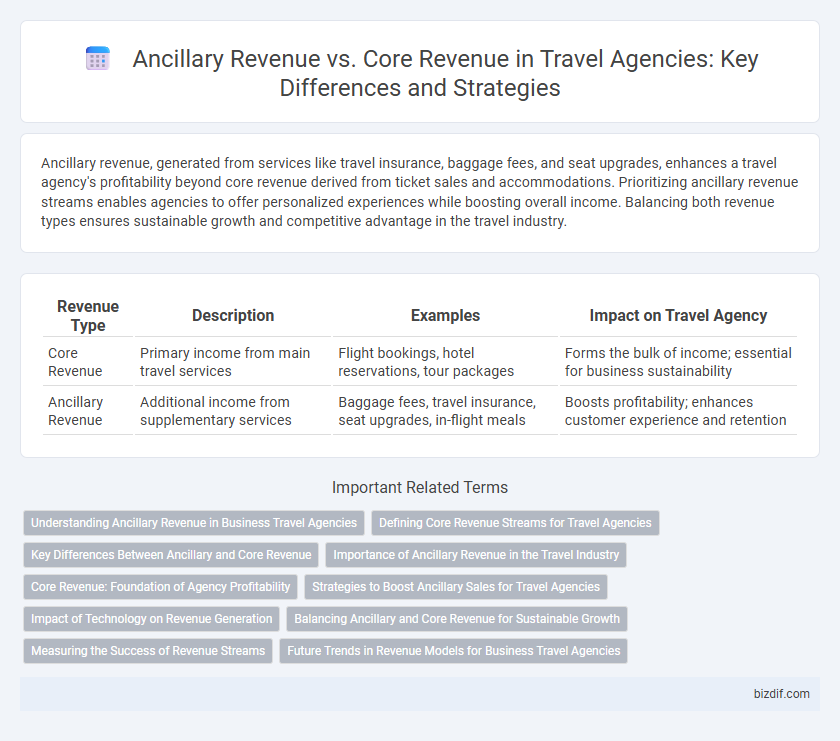Ancillary revenue, generated from services like travel insurance, baggage fees, and seat upgrades, enhances a travel agency's profitability beyond core revenue derived from ticket sales and accommodations. Prioritizing ancillary revenue streams enables agencies to offer personalized experiences while boosting overall income. Balancing both revenue types ensures sustainable growth and competitive advantage in the travel industry.
Table of Comparison
| Revenue Type | Description | Examples | Impact on Travel Agency |
|---|---|---|---|
| Core Revenue | Primary income from main travel services | Flight bookings, hotel reservations, tour packages | Forms the bulk of income; essential for business sustainability |
| Ancillary Revenue | Additional income from supplementary services | Baggage fees, travel insurance, seat upgrades, in-flight meals | Boosts profitability; enhances customer experience and retention |
Understanding Ancillary Revenue in Business Travel Agencies
Ancillary revenue in business travel agencies includes fees from services such as seat upgrades, travel insurance, baggage handling, and airport transfers, which complement the core revenue generated from primary ticket sales and hotel bookings. Understanding ancillary revenue streams enables agencies to diversify income, enhance customer experience, and improve profitability by offering tailored add-ons that meet the specific needs of corporate clients. Effective management of these secondary sources can significantly increase overall revenue without relying solely on core travel arrangements.
Defining Core Revenue Streams for Travel Agencies
Core revenue streams for travel agencies primarily include commissions from flight bookings, hotel reservations, and package tours, which form the foundation of their business model. Ancillary revenue, while complementary, derives from add-ons such as travel insurance, baggage fees, and car rentals, enhancing profitability without replacing core services. Focusing on optimizing core revenue through exclusive partnerships and tailored travel packages ensures sustained growth and customer loyalty in competitive markets.
Key Differences Between Ancillary and Core Revenue
Ancillary revenue in travel agencies includes earnings from optional services such as baggage fees, seat selection, and in-flight meals, while core revenue primarily comes from ticket sales and package bookings. Core revenue represents the main stream generated by the agency's primary offerings, whereas ancillary revenue enhances profitability by providing add-on options that cater to customer preferences. The key difference lies in core revenue being essential for business operation, whereas ancillary revenue serves as supplementary income that diversifies and boosts overall financial performance.
Importance of Ancillary Revenue in the Travel Industry
Ancillary revenue, generated from services such as baggage fees, seat selection, and in-flight sales, significantly boosts profitability for travel agencies by diversifying income streams beyond core revenue like ticket sales. This income stream enhances customer experience through personalized offerings while stabilizing financial performance amid fluctuating demand. Emphasizing ancillary revenue enables travel companies to remain competitive and more resilient in a dynamic market.
Core Revenue: Foundation of Agency Profitability
Core revenue in a travel agency primarily comes from selling flight tickets, hotel bookings, and package tours, forming the foundation of agency profitability. These services generate consistent income streams that support operational costs and sustain business growth. Maximizing core revenue through competitive pricing and personalized offers ensures long-term financial stability and customer loyalty.
Strategies to Boost Ancillary Sales for Travel Agencies
Travel agencies can boost ancillary sales by offering personalized add-ons such as travel insurance, airport transfers, and guided tours tailored to customer preferences. Leveraging data analytics helps identify high-demand ancillary products, enabling targeted promotions that increase average transaction value. Integrating seamless online booking interfaces with clear options for upgrades encourages spontaneous purchases, driving significant ancillary revenue growth without compromising core service quality.
Impact of Technology on Revenue Generation
Technology enhances ancillary revenue by enabling personalized offers such as upgrades, insurance, and local experiences through advanced data analytics and AI-driven platforms. Core revenue benefits from seamless online booking systems and dynamic pricing models that increase direct sales and improve customer satisfaction. Integration of mobile apps and real-time customer insights optimizes cross-selling opportunities, significantly boosting overall revenue streams for travel agencies.
Balancing Ancillary and Core Revenue for Sustainable Growth
Balancing ancillary revenue, such as fees from baggage, seat selection, and in-flight services, with core revenue from ticket sales is crucial for sustainable growth in travel agencies. Optimizing this balance enhances overall profitability while maintaining competitive pricing and customer satisfaction. Leveraging data analytics to tailor ancillary offerings based on customer preferences drives revenue diversification without compromising the core business.
Measuring the Success of Revenue Streams
Measuring the success of revenue streams in travel agencies involves analyzing both ancillary and core revenue performance through key metrics such as revenue per booking, customer lifetime value, and sales growth rate. Core revenue, primarily generated from primary services like flight and hotel bookings, reflects the agency's foundational financial health, while ancillary revenue originating from add-ons such as travel insurance and excursions boosts overall profitability. Tracking conversion rates and average transaction value enables agencies to optimize marketing strategies and service offerings for sustained revenue growth.
Future Trends in Revenue Models for Business Travel Agencies
Future trends in revenue models for business travel agencies emphasize growing ancillary revenue streams, such as personalized travel insurance, premium seat selections, and specialized corporate services, which complement core revenue from flight and hotel bookings. Advanced data analytics and AI-driven personalization enable agencies to tailor ancillary offerings, increasing customer satisfaction and boosting overall profit margins. Embracing seamless integration of these ancillary services into booking platforms will redefine business travel profitability and customer experience.
Ancillary revenue vs Core revenue Infographic

 bizdif.com
bizdif.com